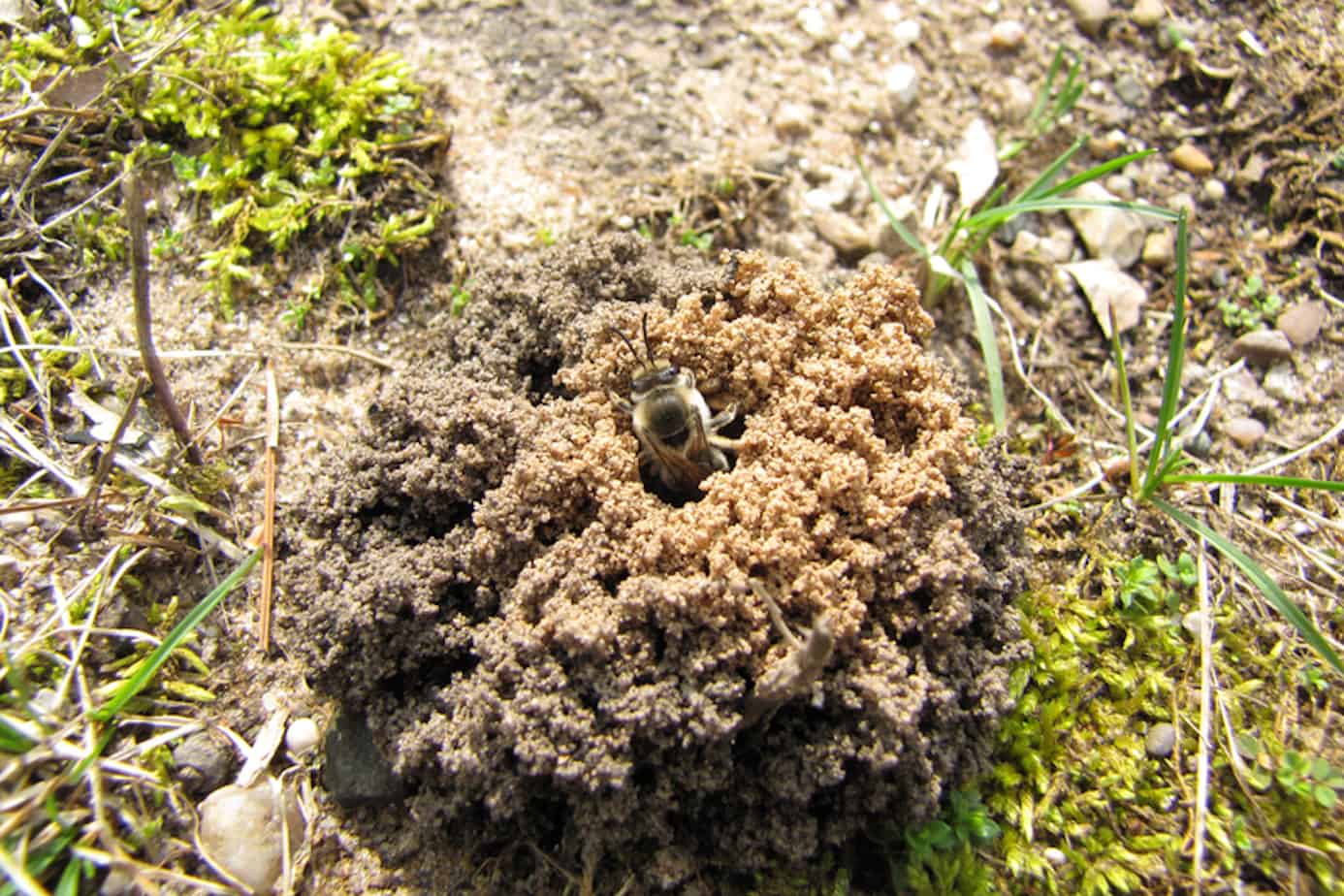If you asked 100 people where bees live, I bet only a handful of them would say in the ground. But it’s true! Several different types of bee actually live underground, not in hives. As a homesteader, knowing what these bees are and whether something should be done about them is critical. Not only are there considerable efforts ongoing to protect our bee populations, but bees also play an incredibly important role in the homestead garden. So, if you’re wondering which bees live in the ground, keep reading to find out more about identification and – if necessary – cruelty-free ground bee prevention.
How to Identify Bees that Live in the Ground
If you suspect you have ground bees, it’s probably because you’ve seen them crawl out of holes in the ground. Sometimes these holes look like little piles of dirt with a hole in the top (the entrance to their burrows). Other times, you might see a bee coming out of a hole that another animal or insect made, usually a small rodent.
Once you’ve spotted them, one of the first things you’re likely to want to know is what species they are. Knowing the species can tell you a lot about what they’re doing on your homestead in the first place, and what role they might be playing in your homestead garden (what type of plants they might be pollinating, for example).
It is usually possible to get reasonably close to a ground bee so you can identify it. As explained later in the post, ground bees are not aggressive and so it’s unlikely they will sting you. But it goes without saying that you shouldn’t try to trap bees to be able to take a closer look and identify them. Even at a distance of a few feet away, you should be able to see enough detail on them to know which bees you have living in the ground.
Common Ground Bee Species
You might be surprised to learn that there are over 20,000 species of bees and more than 70% of them live in the ground. Of these 20,000 species, five are particularly common in North America. Look out for them spring onwards!
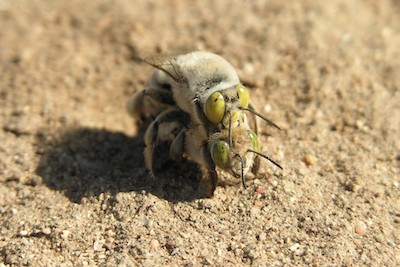
1. Mining bees
‘Miner bees’ is a common synonym for ‘ground bees’, but miner bees are actually a smaller part of the broader ground bee family. Miner bees (centris pallida) – also known as digger bees – tend to be a greyish color, sometimes with yellow on the thorax, and bright yellow-green eyes. They are often confused with honey bees because of their comparable looks and size. Mining bees are solitary creatures, and if you find them digging it’s usually because they’re looking for a female underground to mate with.
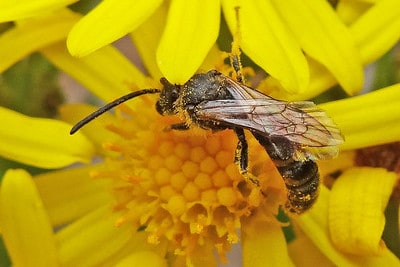
2. Sweat bees
There are over 1000 different types of sweat bees (genus lasioglossum), making identification quite difficult. That said, typically these bees are very small in size (only around 2-8mm) and a dark dusky black or green color. They have little bands of fine hairs going across their abdomen and occasionally you’ll see a dark red tone on the abdomen, too. Sweat bees are generalists so you could find them among many different types of plants. When in the ground, they can be solo or in groups.
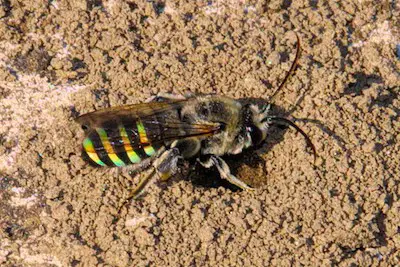
3. Alkali bees
Alkali bees (nomia melanderi) are very important pollinators and are typically found in saltier soils. They look very similar to honey bees but are slightly smaller. The colors on their abdomen tend to be more striking than other ground bees, which can make their identification a little easier. It is worth noting that alkali bees and honey bees are rarely seen together, as honey bees can’t pollinate in the same conditions as alkali bees. Alkali bees are extremely busy, too, able to pollinate over 1,000 flowers a day!
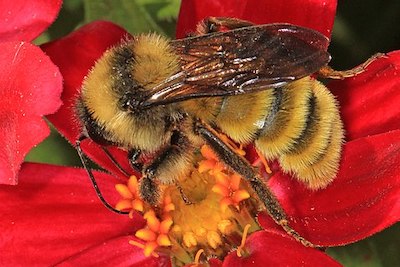
4. Bumble bees
Bumble bees (bombus pensyvlannicus) are endangered natives of North America yet are another incredibly important bee, hence the extensive conservation efforts to save them. Our darling bumble bees like open spaces, so you aren’t likely to find them in closed in areas. They are quite distinctive because of their fuzzy yellow stripes that extend over the abdomen, typically with their black body showing through underneath. Worker bees tend to be 13-19mm whereas queens reach 22–26 mm.
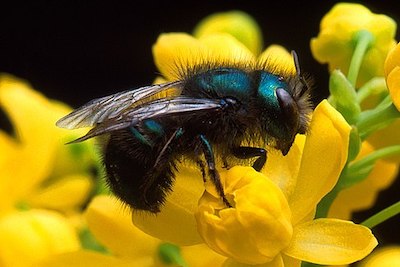
5. Leafcutter bees
Leafcutter bees (megachile spp) are like sweat bees in that there are so many types of them that it can be difficult to identify them. Examples can range from the dark blue-green hairy bees (like the one pictured) to ones with striking yellow and black patterns on their smooth abdomen. These bees identify themselves by cutting circular shapes into leaves, however, so they’re usually easy to spot in that sense. These bees can also be found in ground with rotting wood and other softer textures.
Are Ground Bees Dangerous?
Ground bees are not aggressive, as a general rule. They are fairly content to be around humans and other animals, and they tend to just get on with their day to day work without bothering people. Occasionally, they may fly into you or buzz around your feet if you’re in the grass (which is their home, remember), but in 99% of cases, it’s mere coincidence that you’re in the same spot.
If you see bees buzzing around rapidly and seemingly erratically in a particular area, it’s likely they are male bees trying to protect eligible female bees looking for a mate. These males are harmless, as they have no sting. Female bees are capable of stinging, but they, too, are docile little things and they are not looking for a fight. Female bees, in fact, only sting when they face an imminent threat. Believe it or not, even a queen bee won’t protect the hive by stinging. Rarely do ground bees sting people.
How long does a ground bee sting last?
Did a ground bee sting you? If so, the good news is that ground bee stings are usually mild. Typically, a sting will feel hot and itchy for a few seconds at first, but the pain will soon start to fade. A small red spot could remain a few days after the sting. Ordinarily, however, the spots last no longer than a week. Always seek professional medical advice for suspected allergies or other concerns over bee stings.
How to Prevent Bees Living in the Ground
Are ground bees protected?
Laws vary considerably on this topic. In the United States, many of our state legislatures have passed laws protecting bees and their habitats. It is these laws that make it illegal to use certain pesticides on or near the ground that has bees living in it. Some ground bees are endangered, so the best thing to do is assume that the bees are protected by law. Do your best to find out exactly what the law is in your state. Even if there is no law protecting bees, you should still look for cruelty-free ways to discourage them from living in your ground.
How to eliminate ground bees WITHOUT hurting them
Looking for a quick fix? Considering using chemicals? You probably already know you’re in the wrong place. The recommendations below – when carried out properly – are cruelty-free ways of discouraging bees from turning your lawn or another piece of grassland into their home. Only consider using them if you must (allergies etc. in the family). In 99% of cases, you want to let bees live in the ground, no matter where it is!
Dampen the ground going into next spring
Most ground bees prefer dry soil. If you have dry soil, consider watering it regularly to discourage the bees from making their homes there as you go into next spring season. Do not water soil that already has bees living in it as you will drown them – which is unconscionable – and you’ll lose all the amazing benefits they bring to your plants.
Cover open grass spaces with plants, grasses, or other coverings
Bees like open spaces, for the most part, so if you want to discourage them, you need to close it off a bit. Planting longer grasses or plants that cover the ground in some way is one earth- and bee-friendly way of going this. Bumble bees, in particular, will not be attracted to land that is relatively closed off. This is a simple solution if you can afford to sacrifice a bit of your grassland.
Sprinkle garlic powder around ‘problem’ areas
Bees hate the smell of garlic, apparently. I haven’t asked one myself, but so goes the story. If you sprinkle garlic powder around areas where you typically get ground bees, they’re unlikely to return. Avoid tipping garlic powder down entrances to bee nests, and certainly don’t toss the powder onto any bees directly. Doing so can kill them.
Plant peppermint near ‘problem’ areas
Bees hate another smell – peppermint. If you plant peppermint around your land, particularly in areas where they like to nest, you may have some success deterring them. This method can take a season or two to prove effective, so use it as a supplemental means.
Burn citronella candles
It is frustrating, understandably, when bees fly around your feet and you have to worry about stepping on them. If this is the case, burn citronella candles. Again, bees hate the smell. This is another long-term effort that takes a while to prove effective, but it’s not harmful to the bees so it’s worth considering.
Want to Attract Bees That Live in the Ground?
Excellent news! I’m so glad you’re here. We should be welcoming these gorgeous little creatures into our gardens and homesteads! What are you doing to attract bees into your garden? Let us know in the comments!


